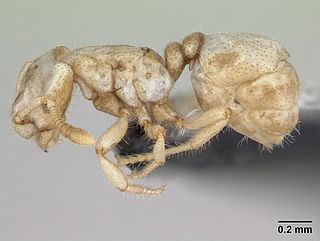
Myrmicinae is a subfamily of ants, with about 140 extant genera; their distribution is cosmopolitan. The pupae lack cocoons. Some species retain a functional sting. The petioles of Myrmicinae consist of two nodes. The nests are permanent and in soil, rotting wood, under stones, or in trees.

Solenopsidini is a tribe of myrmicine ants with about 20 genera.

Lachnomyrmex amazonicus is a species of ant in the subfamily Myrmicinae.

Lachnomyrmex fernandezi is a species of ant in the subfamily Myrmicinae.

Lachnomyrmex laticeps is a species of ant in the subfamily Myrmicinae.

Lachnomyrmex lattkei is a species of ant in the subfamily Myrmicinae.

Lachnomyrmex longinoi is a species of ant in the subfamily Myrmicinae found in Honduras, Nicaragua, Costa Rica.

Lachnomyrmex mackayi is a species of ant in the subfamily Myrmicinae.

Lachnomyrmex nordestinus is a species of ant in the subfamily Myrmicinae.

Lachnomyrmex regularis is a species of ant in the subfamily Myrmicinae.

Lachnomyrmex victori is a species of ant in the subfamily Myrmicinae.

Sphinctomyrmex is a genus of ants in the subfamily Dorylinae. The genus is a tropical and distinctive group, originally described by Mayr based on a single gyne collected in Brazil. Morphologically, the genus is characterized by the unique arrangement of the gastric segments, which are nearly equal in length and separated from each other by distinct constrictions. Very little is known on the natural history of Sphinctomyrmex. The few observations so far suggest that ants of this genus are nomadic predators of other ants. The genus Zasphinctus and approximately 20 species were formerly included, but were split out during revision of the Dorylinae genera by Borowiec (2016).

Blepharidatta is a rare Neotropical genus of ants in the subfamily Myrmicinae. The genus, formed by predatory species whose small colonies nest in soil or leaf-litter, has up to seven species, but most of them are waiting for a formal taxonomic treatment or confirmation.

Nesomyrmex is a genus of ants in the subfamily Myrmicinae. The genus is distributed in the Neotropical, Afrotropical and Malagasy regions. Most species live in arid climates, but some are known from the rainforest. They nest in soil or in trees. Little is known about their biology.

Lachnomyrmex is a Neotropical genus of ants in the subfamily Myrmicinae. The genus consists of 16 species restricted to the Neotropics, known from southern Mexico to northern Argentina. They are most often found in the leaf litter of wet forests, with nests located on the ground. Workers forage alone, apparently without recruiting nestmates or using pheromones. Within the tribe Stenammini, they seem to be most closely related to the genera Lordomyrma of Indo-Australia and Cyphoidris of Africa.

Tropidomyrmex is a Neotropical genus of ants in the subfamily Myrmicinae. The genus contains the single species Tropidomyrmex elianae, known from Brazil.

Tranopelta is a Neotropical genus of ants in the subfamily Myrmicinae.
Megalomyrmex wallacei is a Neotropical species of ants in the subfamily Myrmicinae. Megalomyrmex wallacei can be found in Brazil, Guyana, Colombia, Costa Rica. This species occurs in mature wet forest, usually low-elevation rainforest. Brandão (2003) reports the species nesting under leaves on the forest floor, in colonies of up to 300 workers.
Kempfidris is a Neotropical genus of ants in the subfamily Myrmicinae containing the single species Kempfidris inusualis. Known from Brazil, Ecuador and Venezuela, the species was originally described as Monomorium inusuale in 2007, but was reclassified as the type species for the new genus Kempfidris in 2014. The species is only known from workers and almost nothing is known about their natural history.

















